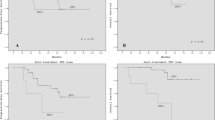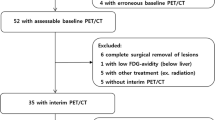Abstract
Purpose
We aimed to compare the standardized central review of 18F-fluorodeoxyglucose (FDG) positron emission tomography (PET)/CT scans performed after induction therapy for follicular lymphoma (FL) in the PRIMA study (Salles et al., Lancet 377:42–51, 2011; Trotman et al., J Clin Oncol 29:3194–3200, 2011) to scan review at local centres.
Methods
PET/CT scans were independently evaluated by two nuclear medicine physicians using the 2007 International Harmonization Project (IHP) criteria (Cheson et al., J Clin Oncol 25:579–586, 2007; Juweid et al., J Clin Oncol 25:571–578, 2007; Shankar et al., J Nucl Med 47:1059–1066, 2006) and Deauville 5-point scale (5PS) criteria (Meignan et al., Leuk Lymphoma 50:1257–1260, 2009; Meignan et al., Leuk Lymphoma 51:2171–2180, 2010; Barrington et al., Eur J Nucl Med Mol Imaging 37:1824–1833, 2010). PET/CT status was compared with prospectively recorded patient outcomes.
Results
Central evaluation was performed on 119 scans. At diagnosis, 58 of 59 were recorded as positive, with a mean maximum standardized uptake value (SUVmax) of 11.7 (range 4.6–35.6). There was no significant association between baseline SUVmax and progression-free survival (PFS). Sixty post-induction scans were interpreted using both the IHP criteria and 5PS. Post-induction PET-positive status failed to predict progression when applying the IHP criteria [p = 0.14; hazard ratio (HR) 1.9; 95 % confidence interval (CI) 0.8–4.6] or 5PS with a cut-off ≥3 (p = 0.12; HR 2.0; 95 % CI 0.8–4.7). However, when applying the 5PS with a cut-off ≥4, there was a significantly inferior 42-month PFS in PET-positive patients of 25.0 % (95 % CI 3.7–55.8 %) versus 61.4 % (95 % CI 45.4–74.1 %) in PET-negative patients (p = 0.01; HR 3.1; 95 % CI 1.2–7.8). The positive predictive value (PPV) of post-induction PET with this liver cut-off was 75 %. The 42-month PFS for patients remaining PET-positive by local assessment was 31.1 % (95 % CI 10.2–55.0 %) vs 64.6 % (95 % CI 47.0–77.6 %) for PET-negative patients (p = 0.002; HR 3.3; 95 % CI 1.5–7.4), with a PPV of 66.7 %.
Conclusion
We confirm that FDG PET/CT status when applying the 5PS with a cut-off ≥4 is strongly predictive of outcome after first-line immunochemotherapy for FL. Further efforts to refine the criteria for assessing minimal residual FDG uptake in FL should provide a reproducible platform for response assessment in future prospective studies of a PET-adapted approach.



Similar content being viewed by others
References
Salles G, Seymour JF, Offner F, López-Guillermo A, Belada D, Xerri L, et al. Rituximab maintenance for 2 years in patients with high tumour burden follicular lymphoma responding to rituximab plus chemotherapy (PRIMA): a phase 3, randomised controlled trial. Lancet 2011;377:42–51. doi:10.1016/S0140-6736(10)62175-7.
Trotman J, Fournier M, Lamy T, Seymour JF, Sonet A, Janikova A, et al. Positron emission tomography-computed tomography (PET-CT) after induction therapy is highly predictive of patient outcome in follicular lymphoma: analysis of PET-CT in a subset of PRIMA trial participants. J Clin Oncol 2011;29:3194–200. doi:10.1200/JCO.2011.35.0736.
Cheson BD, Pfistner B, Juweid ME, Gascoyne RD, Specht L, Horning SJ, et al. Revised response criteria for malignant lymphoma. J Clin Oncol 2007;25:579–86. doi:10.1200/JCO.2006.09.2403.
Juweid ME, Stroobants S, Hoekstra OS, Mottaghy FM, Dietlein M, Guermazi A, et al. Use of positron emission tomography for response assessment of lymphoma: consensus of the Imaging Subcommittee of International Harmonization Project in Lymphoma. J Clin Oncol 2007;25:571–8. doi:10.1200/JCO.2006.08.2305.
Shankar LK, Hoffman JM, Bacharach S, Graham MM, Karp J, Lammertsma AA, et al. Consensus recommendations for the use of 18F-FDG PET as an indicator of therapeutic response in patients in National Cancer Institute Trials. J Nucl Med 2006;47:1059–66.
Meignan M, Gallamini A, Haioun C. Report on the First International Workshop on Interim-PET-Scan in Lymphoma. Leuk Lymphoma 2009;50:1257–60. doi:10.1080/10428190903040048.
Meignan M, Gallamini A, Haioun C, Polliack A. Report on the Second International Workshop on interim positron emission tomography in lymphoma held in Menton, France, 8–9 April 2010. Leuk Lymphoma 2010;51:2171–80. doi:10.3109/10428194.2010.529208.
Barrington SF, Qian W, Somer EJ, Franceschetto A, Bagni B, Brun E, et al. Concordance between four European centres of PET reporting criteria designed for use in multicentre trials in Hodgkin lymphoma. Eur J Nucl Med Mol Imaging 2010;37:1824–33. doi:10.1007/s00259-010-1490-5.
Buske C, Hoster E, Dreyling M, Hasford J, Unterhalt M, Hiddemann W. The Follicular Lymphoma International Prognostic Index (FLIPI) separates high-risk from intermediate- or low-risk patients with advanced-stage follicular lymphoma treated front-line with rituximab and the combination of cyclophosphamide, doxorubicin, vincristine, and prednisone (R-CHOP) with respect to treatment outcome. Blood 2006;108:1504–8.
Federico M, Bellei M, Marcheselli L, Luminari S, Lopez-Guillermo A, Vitolo U, et al. Follicular lymphoma international prognostic index 2: a new prognostic index for follicular lymphoma developed by the international follicular lymphoma prognostic factor project. J Clin Oncol 2009;27:4555–62.
Solal-Céligny P, Roy P, Colombat P, White J, Armitage JO, Arranz-Saez R, et al. Follicular lymphoma international prognostic index. Blood 2004;104:1258–65.
Bachy E, Brice P, Delarue R, Brousse N, Haioun C, Le Gouill S, et al. Long-term follow-up of patients with newly diagnosed follicular lymphoma in the prerituximab era: effect of response quality on survival–a study from the groupe d’etude des lymphomes de l’adulte. J Clin Oncol 2010;28:822–9.
Buckstein R, Pennell N, Berinstein NL. What is remission in follicular lymphoma and what is its relevance? Best Pract Res Clin Haematol 2005;18:27–56.
Bishu S, Quigley JM, Bishu SR, Olsasky SM, Stem RA, Shostrom VK, et al. Predictive value and diagnostic accuracy of F-18-fluoro-deoxy-glucose positron emission tomography treated grade 1 and 2 follicular lymphoma. Leuk Lymphoma 2007;48:1548–55.
Jacobs SA, Swerdlow SH, Kant J, Foon KA, Jankowitz R, Land SR, et al. Phase II trial of short-course CHOP-R followed by 90Y-ibritumomab tiuxetan and extended rituximab in previously untreated follicular lymphoma. Clin Cancer Res 2008;14:7088–94.
Janikova A, Bolcak K, Pavlik T, Mayer J, Kral Z. Value of [18F]fluorodeoxyglucose positron emission tomography in the management of follicular lymphoma: the end of a dilemma? Clin Lymphoma Myeloma 2008;8:287–93.
Le Dortz L, De Guibert S, Bayat S, Devillers A, Houot R, Rolland Y, et al. Diagnostic and prognostic impact of 18F-FDG PET/CT in follicular lymphoma. Eur J Nucl Med Mol Imaging 2010;37:2307–14.
Lopci E, Santi I, Derenzini E, Fonti C, Savelli G, Bertagna F, et al. FDG-PET in the assessment of patients with follicular lymphoma treated by ibritumomab tiuxetan Y 90: multicentric study. Ann Oncol 2010;21:1877–83.
Zinzani PL, Musuraca G, Alinari L, Fanti S, Tani M, Stefoni V, et al. Predictive role of positron emission tomography in the outcome of patients with follicular lymphoma. Clin Lymphoma Myeloma 2007;7:291–5.
Dupuis J, Berriolo-Riedinger A, Julian A, Brice P, Tychyj-Pinel C, Tilly H, et al. Impact of [(18)F]fluorodeoxyglucose positron emission tomography response evaluation in patients with high-tumor burden follicular lymphoma treated with immunochemotherapy: a prospective study from the Groupe d’Etudes des Lymphomes de l’Adulte and GOELAMS. J Clin Oncol 2012;30:4317–22. doi:10.1200/JCO.2012.43.0934.
Itti E, Juweid ME, Haioun C, Yeddes I, Hamza-Maaloul F, El Bez I, et al. Improvement of early 18F-FDG PET interpretation in diffuse large B-cell lymphoma: importance of the reference background. J Nucl Med 2010;51:1857–62. doi:10.2967/jnumed.110.080556.
Meignan M, Gallamini A, Itti E, Barrington S, Haioun C, Polliack A. Report on the Third International Workshop on Interim Positron Emission Tomography in Lymphoma held in Menton, France, 26–27 September 2011 and Menton 2011 consensus. Leuk Lymphoma 2012;53:1876–81. doi:10.3109/10428194.2012.677535.
Gao X, Xue Z, Xing J, Lee DY, Gottschalk SM, Heslop HE, et al. Computer-assisted quantitative evaluation of therapeutic responses for lymphoma using serial PET/CT imaging. Acad Radiol 2010;17:479–88. doi:10.1016/j.acra.2009.10.026.
Wöhrer S, Jaeger U, Kletter K, Becherer A, Hauswirth A, Turetschek K, et al. 18F-fluoro-deoxy-glucose positron emission tomography (18F-FDG-PET) visualizes follicular lymphoma irrespective of grading. Ann Oncol 2006;17:780–4.
Blum RH, Seymour JF, Wirth A, MacManus M, Hicks RJ. Frequent impact of [18F]fluorodeoxyglucose positron emission tomography on the staging and management of patients with indolent non-Hodgkin’s lymphoma. Clin Lymphoma 2003;4:43–9.
Elstrom R, Guan L, Baker G, Nakhoda K, Vergilio JA, Zhuang H, et al. Utility of FDG-PET scanning in lymphoma by WHO classification. Blood 2003;101:3875–6.
Jerusalem G, Beguin Y, Najjar F, Hustinx R, Fassotte MF, Rigo P, et al. Positron emission tomography (PET) with 18F-fluorodeoxyglucose (18F-FDG) for the staging of low-grade non-Hodgkin’s lymphoma (NHL). Ann Oncol 2001;12:825–30.
Karam M, Novak L, Cyriac J, Ali A, Nazeer T, Nugent F. Role of fluorine-18 fluoro-deoxyglucose positron emission tomography scan in the evaluation and follow-up of patients with low-grade lymphomas. Cancer 2006;107:175–83.
Najjar F, Hustinx R, Jerusalem G, Fillet G, Rigo P. Positron emission tomography (PET) for staging low-grade non-Hodgkin’s lymphomas (NHL). Cancer Biother Radiopharm 2001;16:297–304.
Tsukamoto N, Kojima M, Hasegawa M, Oriuchi N, Matsushima T, Yokohama A, et al. The usefulness of (18)F-fluorodeoxyglucose positron emission tomography ((18)F-FDG-PET) and a comparison of (18)F-FDG-pet with (67)gallium scintigraphy in the evaluation of lymphoma: relation to histologic subtypes based on the World Health Organization classification. Cancer 2007;110:652–9.
Weiler-Sagie M, Bushelev O, Epelbaum R, Dann EJ, Haim N, Avivi I, et al. (18)F-FDG avidity in lymphoma readdressed: a study of 766 patients. J Nucl Med 2010;51:25–30.
Wirth A, Foo M, Seymour JF, Macmanus MP, Hicks RJ. Impact of [18F] fluorodeoxyglucose positron emission tomography on staging and management of early-stage follicular non-Hodgkin lymphoma. Int J Radiat Oncol Biol Phys 2008;71:213–9.
Acknowledgments
The PRIMA study was organized by the Groupe d’Etude des Lymphomes de l’Adulte (GELA, now LYSA, Pierre-Bénite, France) with the financial support of Roche Pharma. We thank the GELA-RC team and in particular D. Germain, Project Manager, and the local data management teams within GELA, the Australia Leukaemia Lymphoma Group and the Czech Lymphoma Group. We also acknowledge the following haematologists and PET physicians who submitted the PET scans for central review:
France T. Lamy, E. Garin, H. Tilly, P. Véra, D. Decaudin, V. Edeline, J. Gabarre, A. Hallaj, B. Salles, J.L. Pelletier, P. Colombat, J.L. Beaulieu, C. Sebban, S. Cimarreli, M. Janvier, J.L. Alberini, O. Casanovas, A. Barriolo-Riedinger, J.-L. Harrousseau, O. Couturier, F. Kraeber-Bodere, C. Ferme, D. Lumbroso, D. Guyotat, A.M. Dubois, F. Bauduer, C. Galy-Lacour, D. Bordessoule, J. Monteil, O. Fitoussi, S. Cosculuella-Jarrige, J.-M. Karsenti, L. Tessonier, E. Jourdan, P. Soubeyran, F. Bonichon, A.L. Cazeau; Australia J. Trotman, M. Fulham, J. Estell, P. Marlton, M. Hertzberg, S. Gruenewald, I. Lewis, C. Tiley; Belgium A. Bosly, T. Vander Borght, E. Van Den Neste, M. Lonneux, A. Van Hoof, L. De Ceunicik; Czech Republic A. Oborilova, M. Trneny, H. Siffnerova, J. Prausova, O. Belohlavek, K. Bolcak; Israel O. Shpilberg; Netherlands T. Hageenbeek.
Authorship contributions
The data design, collation and analysis were performed principally by C. Tychyj-Pinel, F. Ricard, M. Fournier, M. Fulham, G. Salles and J. Trotman. Data interpretation, manuscript writing, critique and final approval were performed by all authors.
Conflicts of interest
None.
Author information
Authors and Affiliations
Corresponding author
Rights and permissions
About this article
Cite this article
Tychyj-Pinel, C., Ricard, F., Fulham, M. et al. PET/CT assessment in follicular lymphoma using standardized criteria: central review in the PRIMA study. Eur J Nucl Med Mol Imaging 41, 408–415 (2014). https://doi.org/10.1007/s00259-013-2441-8
Received:
Accepted:
Published:
Issue Date:
DOI: https://doi.org/10.1007/s00259-013-2441-8




